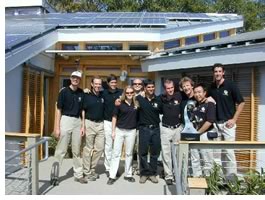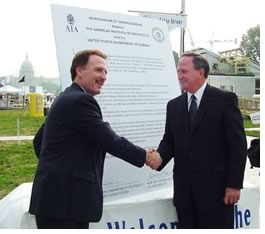
Establishing an early but close lead in the 10-day Solar Decathlon, the team from the University of Colorado at Boulder prevailed when judging ended October 5 and edged out the two other leading contenders, the University of Virginia and Auburn University, who finished second and third respectively.
 Competing
teams designed, financed (including securing donations), tested, transported,
built, operated, and fixed as needed their energy-gathering houses of,
on average, 500 square feet. Held on the Capital Mall next to the Smithsonian
Air and Space Museum, one of the most heavily traversed areas in all of
Washington, the competition was intended to bring public attention to
photovoltaic possibilities and energy efficiency. Competition requirements
included cooking meals, washing clothes, maintaining a comfortable interior
temperature in the unpredictable Washington early autumn (it varied from
sweltering and sunny to raining and muggy), water-temperature testing,
monitoring of battery levels, charging and operating electric cars, operating
a home office, publishing a Web page and newsletter, an evaluation of
construction documents, and, most importantly (it counted for double the
points of any other category), design and livability.
Competing
teams designed, financed (including securing donations), tested, transported,
built, operated, and fixed as needed their energy-gathering houses of,
on average, 500 square feet. Held on the Capital Mall next to the Smithsonian
Air and Space Museum, one of the most heavily traversed areas in all of
Washington, the competition was intended to bring public attention to
photovoltaic possibilities and energy efficiency. Competition requirements
included cooking meals, washing clothes, maintaining a comfortable interior
temperature in the unpredictable Washington early autumn (it varied from
sweltering and sunny to raining and muggy), water-temperature testing,
monitoring of battery levels, charging and operating electric cars, operating
a home office, publishing a Web page and newsletter, an evaluation of
construction documents, and, most importantly (it counted for double the
points of any other category), design and livability.
Competition was fierce, with each team watching the others closely for pointers and possible discrepancies. This is the first year for the Solar Decathlon, which is planned to be a regular event, Energy Secretary Spencer Abraham told the teams September 26 at the opening ceremony.
 Richard
King, the organizer for DOE who inspired the concept two years ago, complimented
the teams for ingenuity and hard work. This will be the most varied Solar
Decathlon because it was the first, he opined. As students see what strategies
worked and didn't work, their entries will become more homogenized over
time, he said.
Richard
King, the organizer for DOE who inspired the concept two years ago, complimented
the teams for ingenuity and hard work. This will be the most varied Solar
Decathlon because it was the first, he opined. As students see what strategies
worked and didn't work, their entries will become more homogenized over
time, he said.
"There are no losers in this event," said Assistant Secretary for Energy Efficiency and Renewable Energy David Garman at the awards ceremony the evening of October 5. Every team deserves recognition for the tremendous amount of work, ingenuity, and dedication that went into the event.
The AIA, a cosponsor of the event organized by DOE and the National Renewable Energy Laboratory, recognized the winners of the Design and Livability competition (the University of Virginia) and the Design Presentation and Simulation competition (Virginia Polytechnic Institute and State University) at the awards banquet. Washington Chapter/AIA Committee on the Environment Chair Lance E. Davis, AIA, presented the two teams with their event trophies. Cosponsors BP Solar, Home Depot, and EDS also presented special-category awards. True to Garman's words, all 14 teams received at least one award that night.
By Tuesday, October 8, the Solar Decathlon Village had disappeared into memory. Yet the seeds it planted in the minds and imagination of the thousands of school children, homeowners, public officials, and design and construction professionals who visited during those 10 days have only begun to grow.
 AIA
and DOE sign MOU
AIA
and DOE sign MOU
In related news, AIA Executive Norman L. Koonce, FAIA, and DOE Assistant
Secretary for Energy Efficiency and Renewable Energy David Garman signed
a memorandum of understanding October 4 at the Solar Decathlon site signifying
the AIA's and DOE's intent to continue a longstanding commitment to develop
renewable energy sources and educate the public and design professions
on energy efficiency in the built environment.
The DOE and AIA memorandum of understanding, initiated by the national
AIA Committee on the Environment, pledges continuing cooperation on:
• Creating buildings conducive to resource efficiency
• Encouraging improvements in the quality of the indoor environment
and occupant productivity
• Advocating increased use of renewable clean energy sources
• Working to reduce the environmental impact of the built environment
• Promoting global economic opportunities through internationally
recognized high-performance design and energy-efficient structures.
"These are ambitious goals," Garman said at the signing ceremony. "But our two organizations have a track record since 1979 that indicates we are more than up to the task. Together, we have delivered symposia and workshops on energy-efficient architecture and sustainable design that have reached more than 70,000 practitioners."
"Changing the mindset of the American people is one of the daunting tasks before us now. We must dispel the sole notion that energy is something we dig or pump from the ground or buy from other nations," Koonce said in his pre-signing remarks. "We must instill a new appreciation [among design professionals and the American public in general] for the intelligence and foresight of developing ways to use renewable energy. And, if the past is prologue, I am confident from our 23 years of working together that we are more than equal to the challenge."
Addressing Garman, Koonce said, "You describe a role that is captured
by the word 'enabler.' You also reject the notion of 'leader' for the
more collaborative concept of 'partner.' This strikes me as wise. It is
wise, because in a democracy, the heavy lifting must be done by the people
through the various institutions or constituencies that represent their
interests—the schools and universities, the great research facilities,
industry, the professions, and their elected leaders at all levels . . .
On behalf of the members of The American Institute of Architects, I eagerly
embrace the knowledge agenda you have set before us."
Copyright 2002 The American Institute of Architects. All rights reserved.
![]()
|
For more information on the Solar Decathlon, including the diaries teams kept during the competition and photographs taken daily, visit the event Web site. |
|